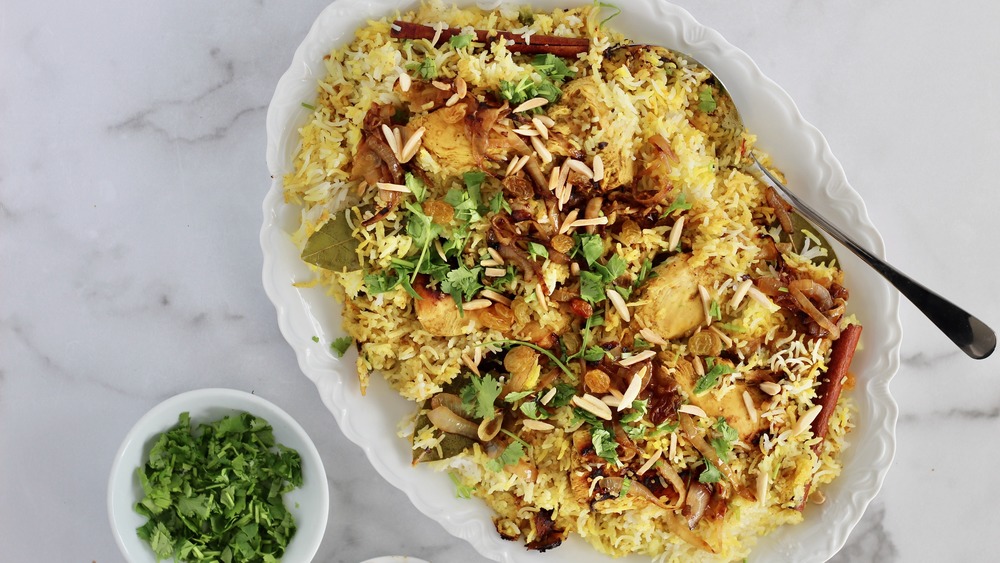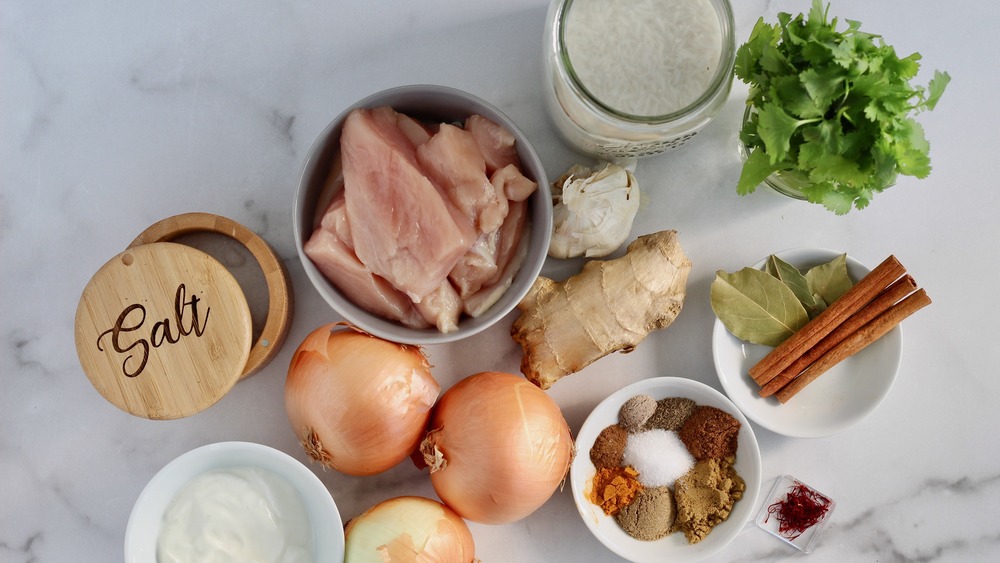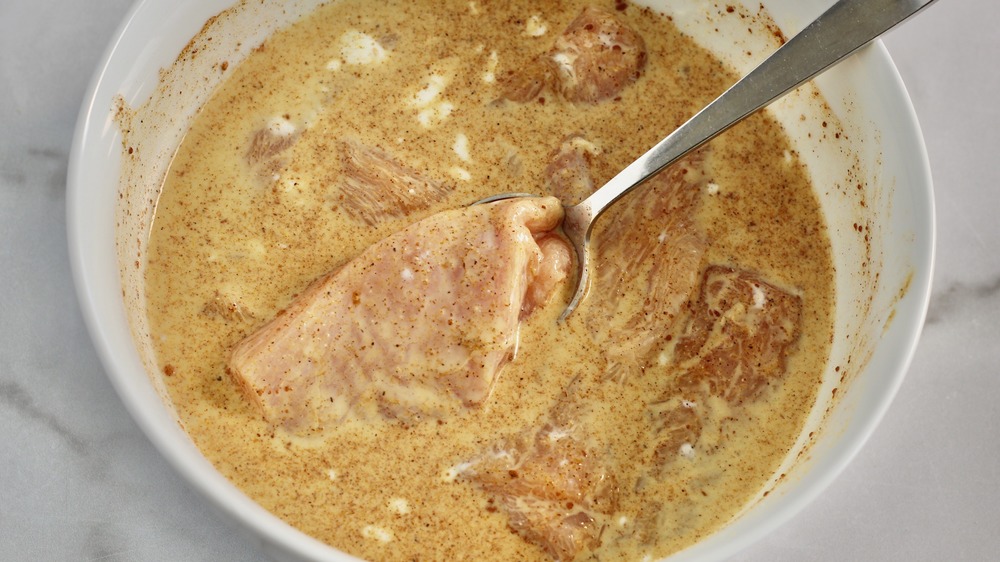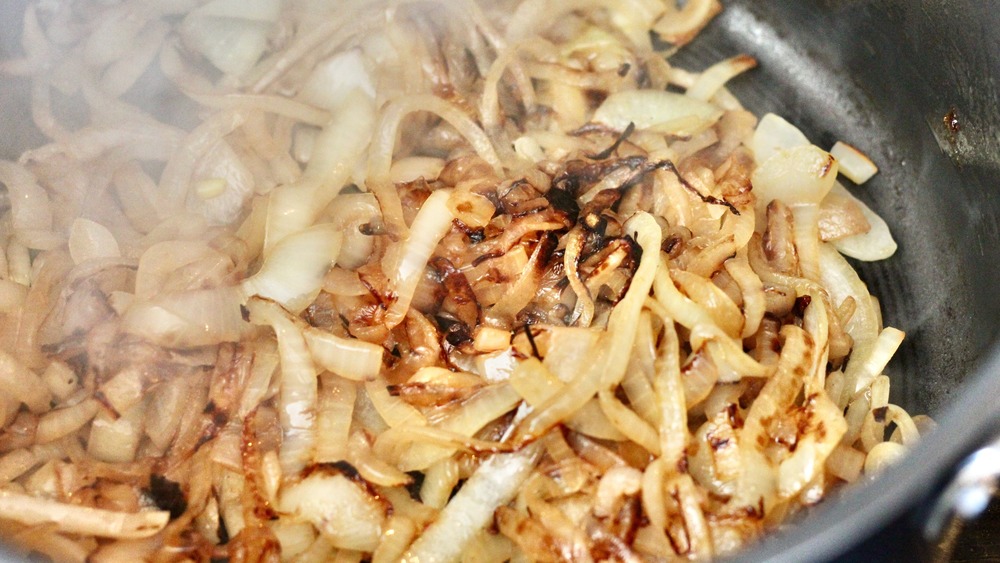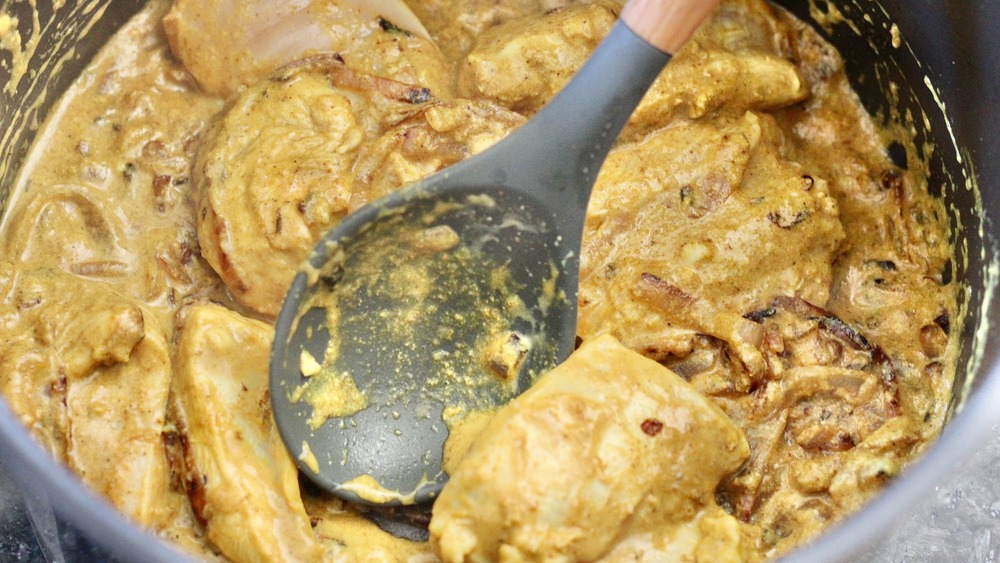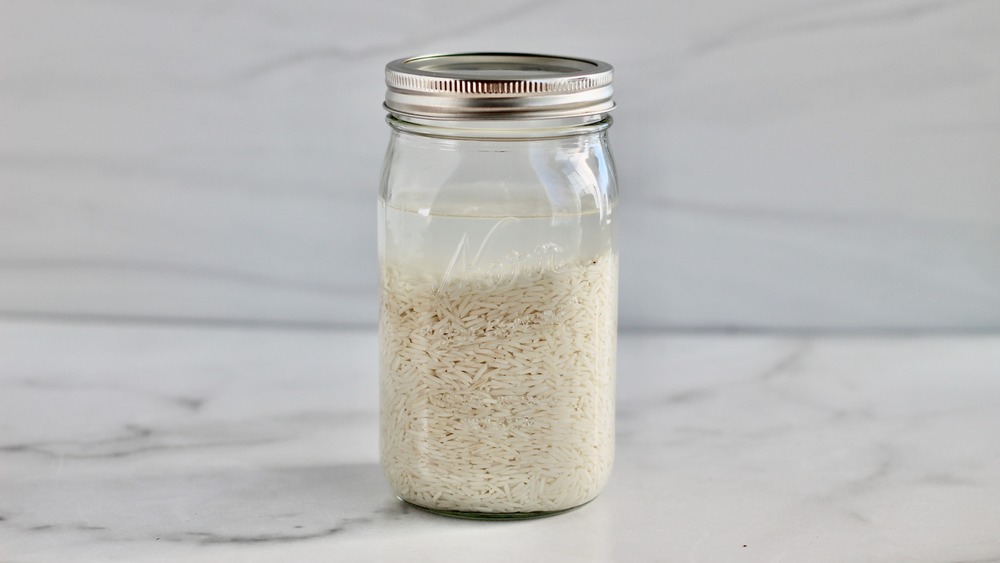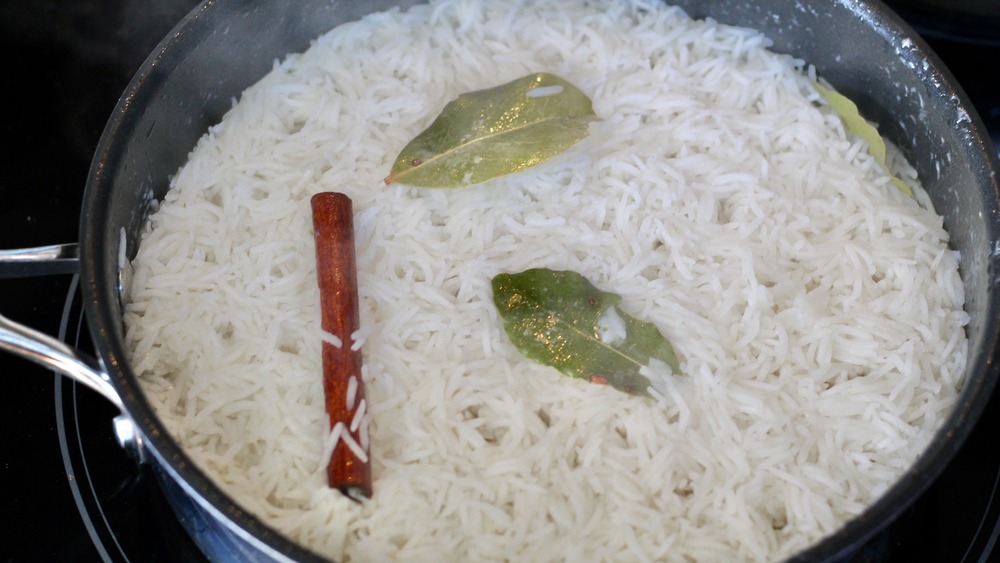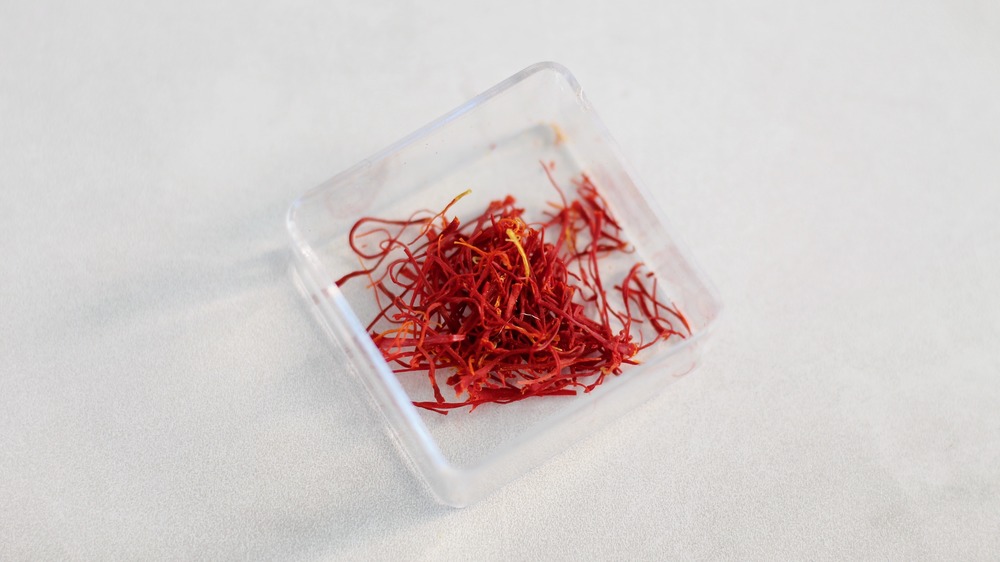Chicken Biryani Recipe
Biryani is an Indian dish layered with spices, aromatics, protein, and rice. It's often topped with fresh herbs, toasted nuts, dried fruit, and fried onions for even more flavor.
The exact origins of biryani are unknown but it's thought to have started in Persia, according to Saveur. Once the dish made its way to South Asia, it really bloomed. As Culture Trip reports, there are varying types of biryanis across India. Hyderabadi biryani focuses on layering meat and rice in a dough-sealed clay pot. Thalassery biryani cooks the ingredients separately and mixes them together at the time of serving, rather than simmering together at the end. Tehari biryani is a type of biryani that omits the meat and focuses on vegetables as the star.
Registered dietitian nutritionist and recipe developer Mackenzie Burgess of Cheerful Choices was inspired to follow some of the same principles and ingredients found in these biryanis with some slightly simplified tweaks. Follow along step-by-step to see how you, too, can create this elegant, aromatic dish in the comfort of your own home.
Gather your chicken biryani ingredients
This recipe calls for quite a few ingredients, but don't let that discourage you from making it. The recipe as written makes enough for four large servings. If you are wanting to make more, simply use a larger pot and double the recipe.
To make chicken biryani, you will need 1 to 1 1/2 pounds chicken breast, cubed, 1 tablespoon grated garlic, 1 tablespoon grated ginger, 2 teaspoons cumin, 1 teaspoon garam masala, 1 teaspoon coriander, 1/2 teaspoon turmeric, 1/4 teaspoon ground cinnamon, 1/4 teaspoon cardamom, 1/4 teaspoon ground black pepper, and 2 teaspoons salt. You will also want to get 1/2 cup plain yogurt, 1/2 cup water, 1/4 teaspoon saffron, 1/4 cup warm water, 4 tablespoons oil, 2 large yellow onions, 3 cinnamon sticks, 3 bay leaves, 2 cups basmati rice, and 3 cups boiling water. Be sure to soak your rice in water for at least 30 minutes beforehand, or overnight.
We believe what really makes this dish special is the vibrant spices. We chose to incorporate garlic, ginger, cumin, garam masala, coriander, turmeric, cinnamon, cardamom, and bay leaves. Of course, you'll find all a wide variety of types and amounts of spices used in biryani recipes so feel free to customize with what you like best.
These unique spices pack in major flavor. If you have any extras afterwards, add them to falafel, muhammara, curries, or homemade hummus. You could also opt to buy a single biryani paste and use that in place of the spices.
Marinate the chicken
First, create your saffron water by simply combining the water and saffron together in a bowl. Set aside.
You can use either chicken breast or chicken thighs for this biryani recipe. Chicken breast will contain fewer calories and fat but can dry out more easily as it cooks. Chicken thighs will contain more fat but can be juicier, especially since the bone is still in for many cuts of this meat. Most traditional recipes will use bone-in chicken thighs, but ultimately use whatever you like best. If you use chicken breast like we did, quarter the breast into large pieces. These larger pieces will help the meat remain juicy.
Add your chicken to a large bowl or Ziploc bag. Then, add your yogurt and spices, taking a minute to thoroughly mix everything together. The yogurt gently tenderizes the meat and adds creamy flavor into the dish. Be sure to use a plain, non-flavored yogurt. Marinate the chicken for at least 20 minutes before cooking or overnight in the refrigerator.
Saute the onions for chicken biryani
You can use either 2 large onions or 3 small onions for this recipe. Either way you should end up with a rather large-looking amount of sliced onions, about 6 cups. This will reduce down quite a bit when cooking, so don't worry too much if you've got a heaping bowl of the fresh stuff at first.
Start by adding a good amount of oil to a large pot. Then, add in your onions and cook until they have turned soft, brown, and caramelized. Set aside half the cooked onions for later, as they will be used as a topping for the finished biryani.
If you're looking for more crunch, you can choose to fry the onions. Just know that this will require a lot more oil. If you don't want to go through the hassle of frying the onions, you can also buy crispy fried shallots to sprinkle on top.
Add in the chicken
After the chicken has marinated, add it to the same pot as the cooked onions. We like to add it one spoonful at a time to prevent the yogurt from curdling, which can happen if the dairy-based yogurt is hit with too much heat or acid at once. Be sure to add in all the liquid from the marinade, as this packs in major flavor from all the spices and is a pretty thirty use of the yogurt, anyway.
Though this biryani does not include any vegetables, you could choose to add in some small diced vegetables, like carrots or potatoes, at this point. If you are looking for more vegetable-focused dishes, check out our Greek salad or one pan roasted vegetables, both of which could act as a great accompaniment to this main dish.
Par-cook your basmati rice for chicken biryani
Basmati rice is the ideal type of rice for biryani because it becomes extra fluffy and light once it's cooked properly. Jasmine rice also makes a great alternative. However, be sure to avoid using brown rice because this particular variety has a longer cook time and isn't always healthier than white rice, anyway. It's also a good idea to let the rice soak for at least 30 minutes before you start cooking, though you can also leave it as long as overnight. Soaking the rice ahead of time helps the rice to produce a beautiful bloomed texture.
When cooking the rice, adding in whole cinnamon sticks and whole bay leaves. These seasonings add complexity and compliment the ground spices that you've already added to the chicken marinade. You'll only cook the rice for about 5 minutes to give it a partial cook, or "par-cook". To do so, first heat 2 tablespoons of oil over a large skillet. Add the cinnamon sticks, bay leaves, and rice, then stir to coat. Add this to a pot of boiling water and salt. Let this come to a simmer, then cover, turn heat to low, and par-cook for 5 minutes. Next, it will be added to the chicken mixture to fully cook and soak up all of the other flavors.
Add rice over the chicken biryani
Once the rice is partially cooked, add it on top of the chicken mixture. Traditionally biryani consists of multiple layers between the chicken and rice. This allows for more of the flavors to infuse into the rice. However, to keep it simple here, we are using just two layers for this recipe: the chicken on the bottom and the rice on top.
Use a spatula to press the rice on top of the chicken and form a smooth layer. Make sure that the heat is at its lowest setting to prevent the chicken from overcooking or burning. Then, drizzle the saffron water on top of the rice. Turn the heat to low, cover with a lid, and cook for another 20 minutes before serving.
Drizzle saffron water over the chicken biryani rice
Alongside truffles and caviar, saffron is one of the most expensive ingredients in the world due to the intensive labor required to harvest it. It's a good thing you only need a pinch for this recipe. You can find it at an international market or your local grocery store. You may also be able to grab a small amount at a local spice shop. It's possible to find some substitutes for saffron, though nothing has quite the same flavor as the original spice.
Once the biryani has cooked through, it's ready to serve. Serve straight from the pot or spoon over a fancy platter. Don't forget to add more cooked onions over top. We also recommend garnishing with cilantro, toasted almonds, golden raisins, and more yogurt over top. If you manage to not devour this dish in one sitting, you can store it for up to 4 days in the refrigerator in an airtight container.
biryani recipe
Chicken biryani is a flavorful and classic Indian dish. Follow along step-by-step to see how you, too, can create this elegant, aromatic dish in your own home.
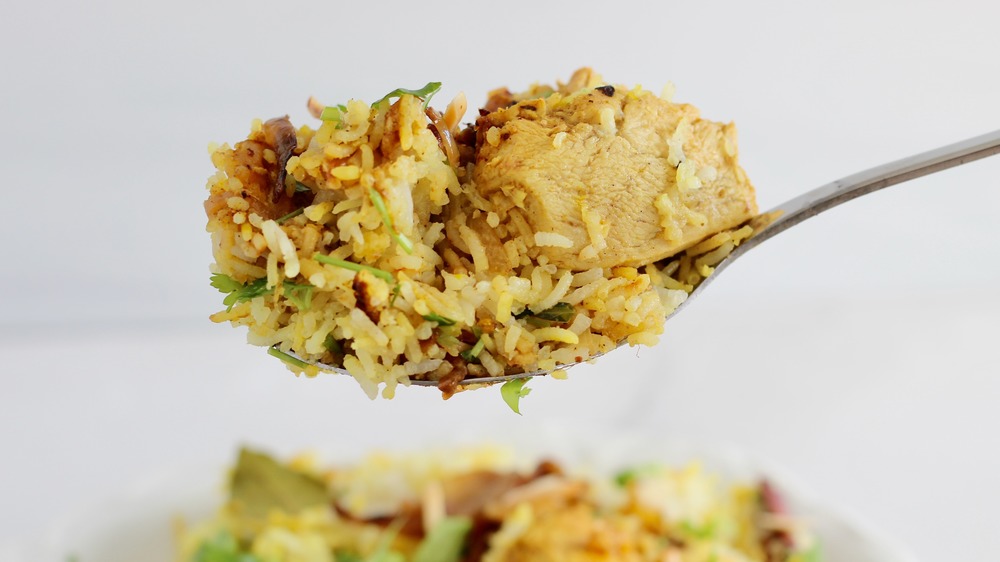
Ingredients
- 2 cups basmati rice, soaked
- 1 to 1 1/2 pounds chicken breast, cubed
- 1 tablespoon garlic, grated
- 1 tablespoon ginger, grated
- 2 teaspoons cumin
- 1 teaspoon garam masala
- 1 teaspoon coriander
- 1/2 teaspoon turmeric
- 1/4 teaspoon ground cinnamon
- 1/4 teaspoon cardamom
- 1/4 teaspoon ground black pepper
- 2 teaspoons salt, divided
- 1/2 cup plain yogurt
- 3/4 cup water, divided
- 1/4 teaspoon saffron
- 4 tablespoons oil, divided
- 2 large yellow onions, finely sliced (about 6 cups)
- 3 cinnamon sticks
- 3 bay leaves
- 3 cups boiling water
Optional Ingredients
- 1 cup finely chopped cilantro
- Toasted blanched almonds
- Golden raisins
Directions
- Soak the rice in water for at least 30 minutes or overnight.
- Combine chicken, garlic, ginger, cumin, garam masala, coriander, turmeric, cinnamon, cardamom, black pepper, 1 teaspoon salt, yogurt, and 1/4 cup water together in a large bowl or zip-top bag. Marinate chicken for 20 minutes or overnight.
- Create saffron water by combining saffron and 1/2 cup water. Set aside for later
- In a large pot on medium-high heat add 2 tablespoons of oil. Add onions and cook until golden brown, about 10 minutes. Stir frequently to prevent burning. Remove half of the onions and set aside for later.
- Bring heat down to medium and add the chicken into the same pot, one spoonful at a time. Include the rest of the yogurt marinade. Cook for 3 minutes, stirring frequently.
- Heat 2 tablespoons of oil over a large skillet. Add cinnamon sticks, bay leaves, rice, and stir to coat. Add over boiling water and 1 teaspoon salt. Let come to a simmer, cover, then turn heat to low and par-cook for 5 minutes.
- Add par-cooked rice into the pot over the chicken mixture. Drizzle the prepared saffron water on top.
- Turn heat to low, cover with a lid, and cook for another 20 minutes.
- Top biryani with cilantro and reserved caramelized onions. You can also garnish with toasted blanched almonds, golden raisins, and more yogurt if desired.
Nutrition
| Calories per Serving | 851 |
| Total Fat | 29.5 g |
| Saturated Fat | 5.8 g |
| Trans Fat | 0.2 g |
| Cholesterol | 94.7 mg |
| Total Carbohydrates | 105.1 g |
| Dietary Fiber | 7.7 g |
| Total Sugars | 13.1 g |
| Sodium | 1,293.8 mg |
| Protein | 40.8 g |
